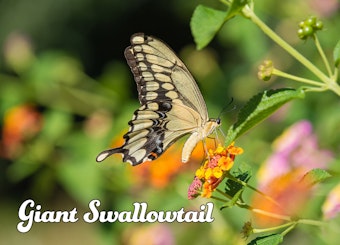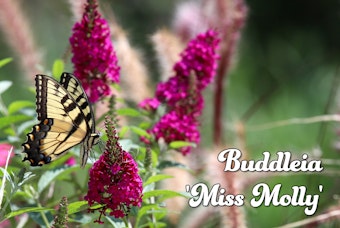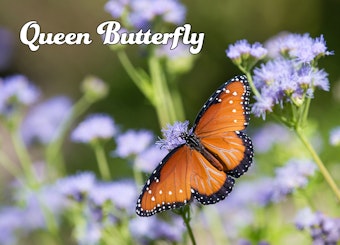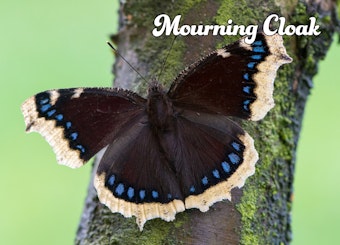Kid's Edition: Plant a Butterfly Garden
 Kids love butterflies! Encourage your child’s sense of connection to the natural world and invite butterflies into your landscape by planting a butterfly garden. A butterfly garden provides a colorful array of nectar-producing plants that not only attract butterflies (and often hummingbirds as well), but offers plants to feed the caterpillar stage of their life cycle. With the appropriate plantings, a butterfly garden provides opportunities to educate your children about the life cycle of a butterfly, allowing them to view each stage of growth and explore the intricate relationships of plants and animals.
Kids love butterflies! Encourage your child’s sense of connection to the natural world and invite butterflies into your landscape by planting a butterfly garden. A butterfly garden provides a colorful array of nectar-producing plants that not only attract butterflies (and often hummingbirds as well), but offers plants to feed the caterpillar stage of their life cycle. With the appropriate plantings, a butterfly garden provides opportunities to educate your children about the life cycle of a butterfly, allowing them to view each stage of growth and explore the intricate relationships of plants and animals.
| Time to Complete | Location | Ages | Season |
|---|---|---|---|
| 3 to 4 hours to plan, gather plants and install; multiple weeks to grow and attract butterflies | Outdoor | All Ages | Spring through Fall |
 Materials
Materials
- In-ground garden space, raised bed, or container garden
- Trowel or shovel
- Flowering plants for adult butterflies
- Host plants for caterpillars
 Instructions
Instructions
Step 1
Begin by finding a garden location that receives at least six to eight hours of sunlight and is sheltered from the wind. Your spot also needs to provide nighttime hiding places for butterflies, such as small trees or large shrubs, and places for them to attach while in their chrysalis.
Step 2
Select plants that grow well in your area. You need to include flowering plants that attract butterflies (many butterflies have favorite plants to sip from) and also leafy “host plants” that attract egg-laying butterflies and provide food for the caterpillars (also known as the larvae). It is always best to select native plants that will attract butterflies native to your area.
When selecting plants, choose a variety of species that bloom throughout the growing season. This will help lure the butterflies to your garden for longer periods. A mixture of annual and perennial plants can offer a wide assortment of blooms when butterflies are most active during mid to late summer. Make it easy for passing butterflies to locate the flowers you’re providing by planting each kind of plant in groups of at least three. Some flowering shrubs are also good butterfly attractors, including lantana, Texas sage, fairy duster, chuparosa, Mexican bird of paradise, blue mist spirea, and glossy abelia. Shrubs are a good addition because they can offer shelter for the butterflies in addition to food.
 Butterfly Bush Varieties
Butterfly Bush Varieties
The aptly named butterfly bush (Buddleia) will also attract them, but be wary about planting it. Most of the varieties offered for sale are cultivars of Buddleia davidii, a species that has escaped from cultivation and become an invasive weed in many parts of the country (the sale of fertile butterfly bush varieties is banned in Washington and Oregon). Breeders have developed some sterile varieties that don’t set viable seeds and are the best choices for including in your garden.
- Buddleia 'Blue Chip' - Part of the "Lo & Behold" series, Buddleia 'Blue Chip' stands out for its compact growth, reaching only 2 to 3 feet in height and width, making it ideal for smaller spaces and container gardens. Notably, it is nearly seedless, significantly reducing its potential for invasiveness. This variety blooms continuously from mid-summer to fall, requires low maintenance, and is drought-tolerant once established. This variety effectively attracts butterflies, bees, and other pollinators, making it a responsible and attractive choice for gardeners.
- Buddleia 'Marrubiifolia' - aka Buddleja marrubiifolia, this variety is native to Mexico and features unique woolly leaves with orange to yellow flowers. It is well-adapted to arid environments like our greater Phoenix metro area, making it highly suitable for xeriscaping. The plant typically exhibits a more restrained growth habit, which helps prevent it from becoming invasive. Its drought tolerance and distinct flower coloration make it an excellent choice for gardeners seeking to add a non-traditional, low-maintenance butterfly bush to their landscapes, particularly those aiming to attract pollinators while minimizing environmental impact.
- Buddleia 'Miss Molly' - Buddleia 'Miss Molly' is celebrated for its vibrant, rich magenta flowers, which are among the most vividly colored in the butterfly bush family. It grows to a moderate size of 4 to 5 feet tall and wide, making it suitable for various garden settings without overwhelming the space. Like others in the series, it has good drought tolerance and requires minimal upkeep. 'Miss Molly' is particularly noted for its long blooming period from summer into fall, attracting a plethora of pollinators such as butterflies and bees. This variety combines striking visual appeal with environmental friendliness due to its reduced seed production, making it a less invasive option for gardeners looking to add both color and wildlife support to their landscapes.
- Buddleia 'Miss Ruby' - Notable for its distinctive magenta-pink flowers, which are particularly vibrant and eye-catching. This moderately sized butterfly bush reaches about 4 to 5 feet in height and width, fitting well into various garden settings without becoming overly dominant. 'Miss Ruby' blooms profusely from early summer to fall, attracting butterflies and bees with its bright and nectar-rich flowers. It is part of a breeding program aimed at producing plants with reduced seed production, thereby minimizing its potential for invasiveness.
- Buddleia 'Pink Micro Chip' - A compact member of the "Lo & Behold" series, growing only about 18 to 24 inches tall and wide, which makes it ideal for small gardens and container planting. It features delicate pink flowers that bloom continuously from mid-summer to fall, providing a long-lasting display of color and a steady source of nectar for butterflies and bees. This dwarf variety is particularly valued for its minimal seed production, significantly reducing its potential to become invasive. It is low maintenance and drought-resistant once established.
- Buddleia 'Pugster Blue'® - This variety stands out for its full-sized, vivid periwinkle blue flowers on a compact, bushy plant. It grows to about 2 feet tall and wide, making it perfectly suited for small spaces and container gardens. It blooms continuously from early summer through frost, providing a long season of color and attracting a host of pollinators, including butterflies and bees. Noteworthy for its thick, sturdy stems, 'Pugster Blue'® maintains good form throughout the growing season and is less likely to become invasive due to its low seed production.
- Buddleia 'Purple Haze' - A unique variety in the "Lo & Behold" series, known for its horizontal, low-spreading habit which makes it ideal for ground cover or cascading over walls and containers. It grows to about 2 to 3 feet tall and wide, with deep purple flowers that bloom abundantly from mid-summer until frost. This continuous blooming not only provides a stunning visual display but also ensures a consistent food source for butterflies and bees. 'Purple Haze' is designed to be non-invasive, producing minimal seeds, which helps prevent unwanted spread in the garden. This variety is also drought-tolerant and requires little maintenance.
 Common Butterflies for the Phoenix Metro Area
Common Butterflies for the Phoenix Metro Area
In the Phoenix, AZ area, you can find a variety of butterfly species due to the region's warm climate and diverse habitats. Here are some of the top butterfly species commonly spotted in the Valley of the Sun:
| Butterfly | Scientific Name | Description | Host Plants | Nectar Plants |
|---|---|---|---|---|
| Queen Butterfly | Danaus gilippus | Easily recognizable by its orange and black wings, similar to the monarch but slightly smaller and with more rounded wings. | Mainly milkweed plants (Asclepias species). | They favor flowers like lantana, verbena, and butterfly bush (see recommended varieties above). |
| Giant Swallowtail | Papilio cresphontes | The largest butterfly in North America, it has distinctive yellow and black markings. | Citrus trees (such as lemon and orange), rue (Ruta graveolens). | Include lantana, azaleas, and Japanese honeysuckle. |
| Painted Lady | Vanessa cardui | Known for its orange, black, and white markings, this butterfly is one of the most widespread species in the world. | A wide range, including thistles, hollyhocks, and legumes like mallow. | They enjoy cosmos, blazing star, aster, and joe-pye weed. |
| American Snout | Libytheana carinenta | Named for its unique elongated “snout,” this butterfly has camouflaged wings that resemble dead leaves. | Hackberry trees (Celtis species). | They typically feed on a variety of flowering plants, including goldenrod and aster. |
| Two-tailed Swallowtail | Papilio multicaudata | Arizona’s state butterfly, it has yellow wings with black striping and two tails on each hind wing. | Mainly trees and shrubs including hop tree (Ptelea trifoliata), ash (Fraxinus), and cherry (Prunus). | Flowering plants like honeysuckle, milkweed, and thistles. |
| Sleepy Orange | Eurema nicippe | A small, bright orange butterfly often found in open fields and along roadsides. | Plants in the pea family, particularly senna and cassia species. | Prefers flowers such as milkweed, goldenrod, and clovers. |
| Mourning Cloak | Nymphalis antiopa | Recognizable by its dark maroon wings with a yellow border and blue spots, the mourning cloak has a long lifespan for a butterfly. | Willow, elm, and aspen trees. | They are less dependent on flower nectar and often feed on tree sap, rotting fruit, and mud puddles for minerals. |
| Marine Blue | Leptotes marina | A small butterfly with pale blue wings, often found around leguminous plants which their larvae feed on. | Various legumes, especially pea family members like alfalfa and clovers. | They are attracted to small, white flowers such as white clover, and also enjoy lantana and verbena. |
These species vary in their abundance throughout the year, with some being more prevalent during specific seasons due to migratory patterns and breeding cycles.
The host and nectar plants associated with each species are crucial for the survival of the butterflies, providing essential resources for their growth, reproduction, and migration.

Step 3
Plant your garden. Add one or two large, flat rocks in the sun so butterflies have a place to bask when mornings are cool. Since butterflies cannot drink from open water, provide them with a “puddle” by filling a container, such as an old birdbath, with wet sand where they can perch and drink safely.
Step 4
Once the garden is planted, stand back and wait for the butterflies to stop by. With a successful butterfly garden, your kids will be able to observe the developmental process of a butterfly. The eggs soon hatch, and the larvae appear and eat the leafy growth of the host plant, eventually developing into full-grown caterpillars. Remember, you will need to tolerate some leaf damage from your very hungry garden guests. Later, these caterpillars affix themselves to a twig or branch and form a chrysalis, entering the pupa stage. Within about two weeks, they metamorphose into butterflies and re-emerge.
* Special Note: Avoid all pesticides. Butterflies are insects, so it makes sense that insecticides — even those labeled “organic” — can harm them. Herbicides used to quell weeds can also harm nectar and host plants. If you feel that you must control pests, start with hand-picking or squishing the offenders, and make the area attractive to pest predators (ladybugs, lacewings, birds). To keep weeds in check, maintain a layer of mulch and pull weeds regularly.
Source: KidsGardening.org ©2024 KidsGardening.org. All Rights Reserved | KidsGardening is a nonprofit educational organization. Support provided by sponsors and donors is critical to our ability to provide free garden-based resources for parents and educators. All gifts are tax-deductible.

